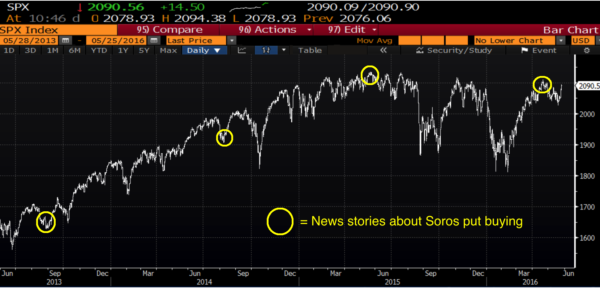What if you saw a headline that said that a brilliant billionaireinvestor, whose every move is closely watched, had put on a trade that wasn’t widely known — and if it were, it might rumble through the markets?
Would you click on that link?
Now what if you were told that the media reported this same trade by this same investor for five years running, and mentioned that there was no proof it was true — and that even if it was true, the bet seemed to be wrong and had had no impact on markets? I assume you would skip that post, right?
Let’s call it adventures in confirmation bias.
The scenario above describes just how overhyped and misleading headlines have become as a staple of web-published market commentary.
I recently was reminded of how many empty news calories many readers consume, courtesy of Michael Harris of Price Action Lab Blog. Harris is an engineer and systems developer who has put his graduate engineering degrees to use analyzing markets and developing trading systems. His critical thinking about back-testing and data-mining often has proven wonderfully insightful.
Harris highlighted a classic example of the click-bait approach with a simple chart of the Standard & Poor’s 500 Index, annotated to show every time a news story reported that George Soros’ investment fund was buying puts on the index, or making a bet that the market would fall. Below I’ve reproduced Harris’ chart on the Bloomberg:
click for ginormous chart

There are some lessons here, including but not limited to:
- Your financial plans, and the investing goals of most people, are very different from those of a billionaire;
- Soros’ puts might be a hedge against another and opposite position, meaning that he actually is betting the market will rise — but just in case it doesn’t, he’s taken out a bit of insurance;
- The information could be old, and not reflective of current positions;
- The writer may have an axe to grind with Soros’ politics or ideology, and;
- Soros’ market call could be wrong.
It isn’t just Soros who is cited regularly in these kinds of posts and articles. Michael Price and Larry Swedroe do an admirable job of taking down the perennially wrong pundits who cite this random fact or that ad-hoc tidbit as empirical support for their views.
We have discussed aspects of this before. In this vein I have pointed out some folks who make the same market call year after year, regardless of what happens in the economy, markets or with corporate profits. Marc Faber’s annual prediction of a “1987 like-crash” is a perfect example. He did change it up earlier this year, when he said that “asset markets will crash like Titanic.” Despite a seven-year streak of being wrong, he must be awarded points for creativity for that one, substituting events that occurred 104 years ago for those that happened merely 30 years ago.
I don’t want to pick on Faber, who is an appealing media personality and makes for great entertainment whenever he speaks about any subject. It’s just that entertainment isn’t a sound base on which to build your portfolio. Lots of talking heads are much worse, and with more dubious motives.
Why does this annual farce go on? Because it works. Juicy headlines attract clicks, and people who make (and repeat) outrageous claims attract eyeballs and capital. Why people feel obligated to give theirmoney to these mystics is beyond my understanding, but it is effective, and so it continues.
As a public-service reminder to pundits and click mongers — people may forget, but the internet remains indexed and Google-searchable for a long time.
So please folks, don’t encourage this foolishness by giving in to the temptation to click on every salacious, but misleading, headline you see. You will only encourage them.
Originally: Kick the Click-Bait Habit


What's been said:
Discussions found on the web: